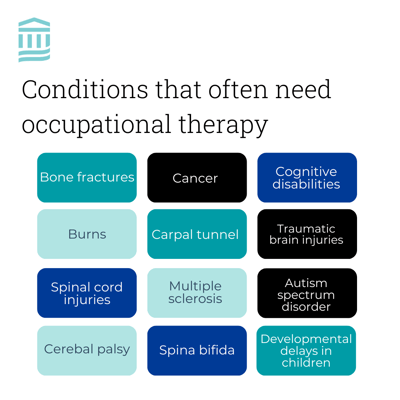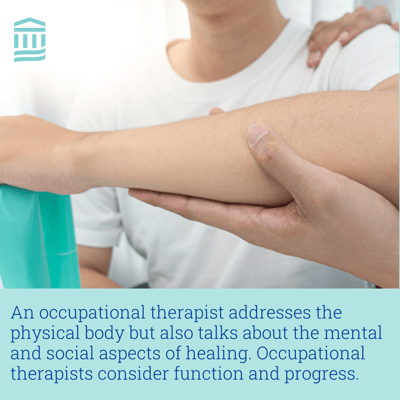Recognizing occupational therapy month
In recognition of Occupational Therapy Month in April, let's take a deeper look at this specialty and how these professionals help clients live with greater ability. Here are some top questions about occupational therapists, including how the profession is unique.
What do occupational therapists do?
According to the U.S. Bureau of Labor Statistics (BLS), occupational therapists treat clients who have injuries, illnesses, limitations, or disabilities, so they can more easily do physical tasks as part of their daily routine or work.
Considered healthcare providers, these therapists help people live as self-sufficiently as possible—for instance, they assess how someone sits, stands, and moves and then create a therapy plan allowing them to do those actions safely and effectively.
Although they do assist people with getting back to a job after a trauma or injury, "occupational" doesn't cover only work-related issues. You might see one of these therapists after a shoulder surgery, for example, to learn how to get dressed, drive a car, and take a shower without pain. Or someone who's had a stroke might see an occupational therapist to re-learn everyday tasks as part of a more comprehensive recovery plan.
Some other conditions that often need occupational therapy include:
- Bone fractures
- Cancer
- Cognitive disabilities
- Burns
- Carpal tunnel syndrome
- Traumatic brain injuries
- Spinal cord injuries
- Multiple sclerosis
- Autism spectrum disorder
- Cerebral palsy
- Spina bifida
- Developmental delays in children
The demand for occupational therapists is growing, the Bureau of Labor Statistics reports. They estimate there will be 10,000 (or more) new openings for these professionals each year for at least the next decade.
How are occupational therapists different than physical therapists?
Although both types of therapists focus on helping people move better and regain mobility, the difference between them is the end goal. In some cases, you may see both types of professionals during a rehabilitation process.
Physical therapy addresses a specific area of the body that's been affected by injury, surgery, or a health condition. The goal is to reduce symptoms like pain and stiffness and build strength around that part of the body. For example, someone with a knee replacement would see a physical therapist to strengthen the muscles around the knee joint and gain greater flexibility as a way to reduce movement limitations.

An occupational therapist addresses the physical body but also talks about the mental and social aspects of healing. Occupational therapists consider function and progress. In the case of knee replacement, that might mean learning exercises that help a client get back to running or cycling or back to doing a physical job that requires lifting and squatting.
An occupational therapist will also set goals that drive a treatment plan. For instance, if you're a runner and want to race again, you and your therapist might choose a 5K that's six months away and create a plan that helps you progress safely toward that goal. In some cases, those goals might be much more modest, like being able to put on socks or cook your own dinner.
What type of education do occupational therapists receive?
In the U.S., all occupational therapists must be licensed and certified. This requires a bachelor's degree as well as a master's degree in occupational therapy.
It usually takes six to seven years to become an occupational therapist, and they have to pass a certification exam. Some states have additional licensure or exam requirements. Although many therapists work with a wide range of clients, others choose to do additional fieldwork in order to specialize in a core practice area, such as working with children and teens, helping those injured on the job, or assisting those with mental health challenges.
How do I know if I need to see an occupational therapist?
You don't need to have a traumatic injury or disability to be a good fit for occupational therapy—you may have a chronic condition like low back pain or mobility limitations that restrict what type of everyday activities you can do. If you feel you could benefit from this type of therapy, talk to your doctor. You can also learn more about the occupational therapy services at Brigham and Women's Hospital and Mass General.
For more health and wellness education from Mass General Brigham Health Plan, follow us on social @MGBHealthPlan
⬇️




